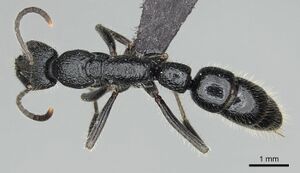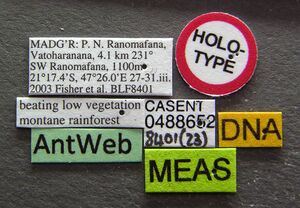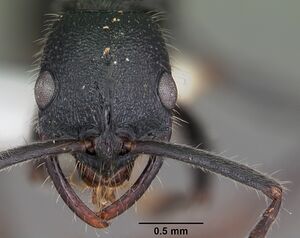Leptogenys namana
| Leptogenys namana | |
|---|---|

| |
| Scientific classification | |
| Kingdom: | Animalia |
| Phylum: | Arthropoda |
| Class: | Insecta |
| Order: | Hymenoptera |
| Family: | Formicidae |
| Subfamily: | Ponerinae |
| Tribe: | Ponerini |
| Genus: | Leptogenys |
| Species group: | incisa |
| Species complex: | imerinensis |
| Species: | L. namana |
| Binomial name | |
| Leptogenys namana Rakotonirina & Fisher, 2014 | |
Leptogenys namana is widespread in the humid forest habitats of eastern Madagascar, but are rarely found, particularly in the north of the island. Worker specimens were found foraging on lower vegetation, even though the colony nests were collected from rotten logs.
Identification
A member of the imerinensis complex of the incisa species group. Rakotonirina and Fisher (2014) - Worker. Anterior margin of median lobe of clypeus with two small, peg-like setae; medial clypeal carina sharp; antennal scape relatively short (SI: 115–118), less than apical third extending beyond posterior cephalic margin; in dorsal view, mesosoma consists of three visible segments, with no distinct segment between metanotal groove and propodeum; propodeal posterior margin with toothlike lobe; head dorsum densely and finely reticulate-rugose; propodeal dorsum coarsely rugose; declivity surface not distinctly delimited, side of propodeum roughly rounding to the declivity. Smaller species.
Leptogenys namana is morphologically quite variable, especially in the width of the translucent lamella, the extent of sculpture on the head, mesosoma and petiolar node, the presence of toothlike propodeal lobe, and the shape of the petiolar node. A worker specimen from the RS Marotandrano has a finely reticulate-punctate head dorsum, microreticulate propodeal dorsum superimposed with sparse punctures, and the absence of a toothlike lobe on propodeal posterior margin. Some specimens from southern Madagascar have a propodeal declivity not well delimited by posterolateral margin, with the sides of the propodeum rounding to the almost slightly convex declivitous surface.
Keys including this Species
Distribution
Latitudinal Distribution Pattern
Latitudinal Range: -15.0353° to -21.29°.
| North Temperate |
North Subtropical |
Tropical | South Subtropical |
South Temperate |
- Source: AntMaps
Distribution based on Regional Taxon Lists
Malagasy Region: Madagascar (type locality).
Distribution based on AntMaps
Distribution based on AntWeb specimens
Check data from AntWeb
Countries Occupied
| Number of countries occupied by this species based on AntWiki Regional Taxon Lists. In general, fewer countries occupied indicates a narrower range, while more countries indicates a more widespread species. |

|
Estimated Abundance
| Relative abundance based on number of AntMaps records per species (this species within the purple bar). Fewer records (to the left) indicates a less abundant/encountered species while more records (to the right) indicates more abundant/encountered species. |

|
Biology
|
Castes
Worker
Images from AntWeb
   
| |
| Holotype of Leptogenys namana. Worker. Specimen code casent0488652. Photographer Estella Ortega, uploaded by California Academy of Sciences. | Owned by CAS, San Francisco, CA, USA. |
   
| |
| Worker. Specimen code casent0102925. Photographer April Nobile, uploaded by California Academy of Sciences. | Owned by NHMUK, London, UK. |
   
| |
| Worker. Specimen code casent0134243. Photographer Jean Claude Rakotonirina, uploaded by California Academy of Sciences. | Owned by CAS, San Francisco, CA, USA. |
Nomenclature
The following information is derived from Barry Bolton's Online Catalogue of the Ants of the World.
- namana. Leptogenys namana Rakotonirina & Fisher, 2014: 91, figs. 49B, 52B, 54A, 104, 120 (w.) MADAGASCAR.
Unless otherwise noted the text for the remainder of this section is reported from the publication that includes the original description.
Description
Worker
(9 specimens). HW: 1.10–1.25, HL: 1.31–1.51, CI: 78–83, SL: 1.31–1.50, SI: 118–128, PW: 0.92–1.06, WL: 2.25–2.64, PNH: 0.75–0.84, PNL: 0.71–0.83, PNW: 0.71–0.78, DNI: 91–105, LNI: 95–107.
Head in full-face view subrectangular, lateral border slightly convex and weakly diverging anteriorly. Eye large, weakly convex; in full-face view, location feebly breaking outline of lateral border of head. Antennal scape moderately short, apical fourth section approximately surpassing posterior margin of head. Clypeus with convex lateral lobes, whose margin converge anteriorly into a triangular median lobe; anteromedian lobe bordered with two peg-like setae; narrow translucent lamella broadly convex along lateral border of clypeus and angulate at anteromedian margin; median longitudinal carina of clypeus sharp. Mandible elongate and slender, fairly curved at base and inner margin slightly concave; preapical denticle present near sharp apical tooth; basal groove vestigial to faintly effaced. Hypostomal teeth visible in full-face view of head. Metanotal groove impressed; mesosoma in dorsal view consists of three segments, with no additional suture visible between metanotal groove and propodeum. In profile, mesosoma generally long and low; posterolateral margin of propodeum with toothlike lobe; declivitous surface not clearly defined, lateral surface and dorsum of propodeum joining declivity in a rounded angle. Petiolar node in profile generally as high as broad, dorsal margin convex and anterior and posterior faces weakly inclined anteriorly. In dorsal view, petiolar node longer than broad and slightly narrower in front than behind. Constriction distinctly visible between third and fourth abdominal segments. Mandible generally sparsely punctate, with a smooth and shining surface on basal portion and fine striation near apex. Sculptures of head dorsum, mesosoma and petiolar node densely and finely reticulate-punctate to densely and finely reticulate-rugose. Third abdominal tergite finely microreticulate, with scattered shallow punctures; the fourth almost smooth and shining. Erect, slender, yellowish hairs present on dorsum of body, pubescence abundant on head and appendages and reduced or lacking on rest of body dorsum. Integument black, tarsa, apex of antenna, mandible and gaster brown or light brown.
Type Material
Holotype worker: Madagascar, Fianarantsoa, PN Ranomafana, Vatoharanana River, 4.1 km 231° SW Ranomafana, -21.29, 47.4333, 1100 m, montane rainforest, beating low vegetation, 27–31 Mar 2003 (Fisher, Griswold et al.), collection code: BLF08401, specimen code: CASENT0488652 (California Academy of Sciences).
References
- Rakotonirina, J.C. & Fisher, B.L. 2014. Revision of the Malagasy ponerine ants of the genus Leptogenys Roger (Hymenoptera: Formicidae). Zootaxa 3836, 1-163.
References based on Global Ant Biodiversity Informatics
- Rakotonirina J. C., and B. L. Fisher. 2014. Revision of the Malagasy ponerine ants of the genus Leptogenys Roger (Hymenoptera: Formicidae). Zootaxa 3836 (1): 001163.

